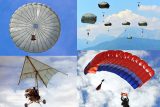What Is It Like Flying in a Small Plane?
Skydiving
Posted by: Long Island Skydiving Center
8 years ago
If you’ve considered skydiving, you’ve probably asked yourself – what is it like flying in a small plane?
Y’know when you’re driving up the highway to an airport to catch a flight and you see the signage pointing to the exit to take for “General Aviation”? Most people are caught off-guard by those signs and exit the highway in the wrong place because gosh darn it, isn’t the phrase “general aviation” a blanket term for, well, aviation in general. And isn’t a passenger flight to your beach vacation or work conference a generally aviation-related thing?
If you’ve been in that frustrating situation, you’ve discovered that – well- it isn’t. “General aviation” (“GA,” for short) is the term for all civil aviation operations outside of scheduled air services and non-scheduled air transport operations for hire. It’s the catchall term for flights ranging from gliders and powered parachutes to pilot schools to private jets (that probably run on tanks of champagne; we don’t know).
If you usually have an e-ticket and a baggage allowance when you get on a plane, there’s a good chance that you’ve never been exposed to general aviation – and that it’ll be part of the getting-to-know-you process when you meet the sport of skydiving for the first time. This article is meant to help you prepare to what to expect when you’re first flying in a small plane. (Spoiler: It’s different from your usual perch in an exit row!)
The ride will feel different.

Skydiving airplanes are smaller than commercial airlines. Like: much smaller. As a rule, the bigger and heavier an airplane, the less affected the plane will be by the dynamics of the air. So: If the bulk of your airborne experience has been in a big ol’ 747, you might be surprised by how much movement a small plane experiences in flight.
You can expect to feel turbulence more easily; to feel the small adjustments that the pilot makes; to get a real sense of how active it really is up there in the sky. Don’t let it make you nervous, though; it’s all part of the experience of flying in a small plane, and it’s really intellectually interesting to think about the details of the meteorology that you’re able to experience firsthand.
You’ll pull up a patch of carpet.

If you’re used to following a letters-and-numbers grid to your favorite aisle seat, you’ll probably be a little surprised to walk up to a smallplane and be instructed to grab a seat on the floor. We’re a pretty darn casual bunch in the skydiving world, right? ;)
Joking aside, the floor seating doesn’t have anything to do with how down-home we are; it’s a function of keeping the plane as light as possible for the quickest ride to exit altitude. You’ll be glad for the minutes that the lightened plane shaves off the ride, too, because…
You’ll be cozy!

Cessnas – the workhorse small planes of the skydiving industry – are … small. This is by design because they’re very efficient little beasts. But you should be aware that you’ll be in close proximity with your instructor, the other jumpers on the plane and the pilot.
Bonus: You’ll be well within high-fiving distance of everyone involved, so don’t forget to dole ’em out!
Get in on the action and book your tandem skydive today!
Categories:
You May Be Interested In:

Skydiving After LASIK: What You Need to Know
2 months ago by Long Island Skydiving Center

What Parachute Types Are There?
2 months ago by Long Island Skydiving Center

How Dangerous is Tandem Skydiving?
4 months ago by Long Island Skydiving Center

Nervous About Skydiving? Here Are Our Top 6 Tips!
4 months ago by Long Island Skydiving Center